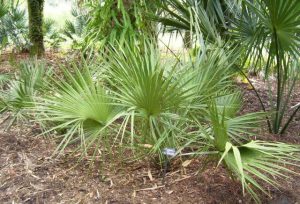 One of a handful of native palms, the Scrub Palmetto (Sabal etonia) is a smaller and less common relative to the ubiquitous Saw Palmetto. It is slow-growing and like the Saw Palmetto, produces berries which provide food for wildlife. Its flowers are also a nectar source for butterflies.
One of a handful of native palms, the Scrub Palmetto (Sabal etonia) is a smaller and less common relative to the ubiquitous Saw Palmetto. It is slow-growing and like the Saw Palmetto, produces berries which provide food for wildlife. Its flowers are also a nectar source for butterflies.Planting Site
The Scrub Palmetto prefers full sun but will tolerate partial shade. It is moderately salt tolerant and does best in moist, well-drained soils. However, it is strongly recommended to direct-plant scrub palmettos from seed as their transplant survival rate is low. Maintaining a clumping growth habit, at maturity, scrub palmettos can be 4 x 6 ft. tall and 4 x 6 ft. wide, so it is important to select a planting site which will provide enough space.
Nutrient requirements
Scrub Palmettos in the landscape typically do not experience significant nutrient deficiencies. Generally, symptoms of nutrient deficiencies include yellowing fronds or yellow/brown spots on fronds. Although a fertilizer specially formulated for palms can be used to address nutrient deficiencies, it is recommended that a soil pH reading is done prior to applying. Click on the link to learn more about palm nutrient requirements fertilizing palms.
Pests and diseases
Scrub Palmettos generally do not experience significant pest and disease issues. However, to support optimal plant health, regularly scouting signs of pests/diseases is recommended.
Learn more:
For more information on Scrub Palmetto, click on this link.
Source: UF/IFAS Pest Alert
Note: All images and contents are the property of UF/IFAS.



